Identification of a Potential Rare Earth Element Deposit at Ivanpah Dry Lake, California Through the Bastnäsite Indices
Abstract
:1. Introduction
2. Materials and Methods
2.1. Airborne and Spaceborne Reflectance Measurements
2.1.1. Common Preprocessing Steps
2.1.2. AVIRIS-NG
2.1.3. AVIRIS-Classic
2.1.4. HISUI
2.1.5. DESIS
2.1.6. EnMAP
2.1.7. EO-1 Hyperion
2.1.8. PRISMA
2.1.9. EMIT
2.2. Bastnäsite Index Mapping
3. Results
3.1. Representative Spectra and Peak Bastnäsite Index Values of the Ivanpah Dry Lake
3.2. Bastnäsite Index Maps of the Ivanpah Dry Lake
4. Discussion
4.1. Representative Spectra and Peak Bastnäsite Index Values of the Ivanpah Dry Lake
4.2. Bastnäsite Index Maps of the Ivanpah Dry Lake
5. Conclusions
Author Contributions
Funding
Data Availability Statement
Acknowledgments
Conflicts of Interest
References
- Gadea, O.C.A.; Khan, S.D. Detection of bastnäsite-rich veins in rare earth element ores through hyperspectral imaging. IEEE Geosci. Remote. Sens. Lett. 2023, 20, 5502204. [Google Scholar] [CrossRef]
- Gadea, O.C.A.; Khan, S.D.; Sisson, V.B. Estimating rare earth elements at various scales with Bastnäsite Indices for Mountain Pass. Ore. Geol. Rev. 2024, 173, 106254. [Google Scholar] [CrossRef]
- Qasim, M.; Khan, S.D.; Sisson, V.; Greer, P.; Xia, L.; Okyay, Ü.; Franco, N. Identifying rare earth elements using a tripod and drone-mounted hyperspectral camera: A case study of the Mountain Pass Birthday Stock and Sulphide Queen Mine Pit, California. Remote Sens. 2024, 16, 3353. [Google Scholar] [CrossRef]
- Olson, J.C.; Shawe, D.R.; Pray, L.C.; Sharp, W.N. Rare-Earth Mineral Deposits of the Mountain Pass District, San Bernardino County, California; Technical Report 261; USGS: Reston, VA, USA, 1954. [Google Scholar] [CrossRef]
- Nystrom, E.C. Chapter eight: Resource management. In From Neglected Space to Protected Space: An Administrative History of Mojave National Preserve: National Park Service; U.S. Department of the Interior: Washington, DC, USA, 2003; Available online: https://npshistory.com/publications/moja/adhi.pdf (accessed on 30 September 2024).
- NV5 Geospatial Solutions. QUAC Background. Available online: https://www.nv5geospatialsoftware.com/docs/backgroundquac.html (accessed on 30 September 2024).
- Pande-Chhetri, R.; Abd-Elrahman, A. Filtering high-resolution hyperspectral imagery in a maximum noise fraction transform domain using wavelet-based de-striping. Int. J. Remote Sens. 2013, 34, 2216–2235. [Google Scholar] [CrossRef]
- Savitzky, A.; Golay, M.J.E. Smoothing and differentiation of data by simplified least squares procedures. Anal. Chem. 1964, 36, 1627–1639. [Google Scholar] [CrossRef]
- Bromba, M.U.A.; Ziegler, H. Application hints for Savitzky-Golay digital smoothing filters. Anal. Chem. 1981, 53, 1583–1586. [Google Scholar] [CrossRef]
- Guha, A.; Ghosh, U.K.; Sinha, J.; Pour, A.B.; Bhaisal, R.; Chatterjee, S.; Baranval, N.K.; Rani, N.; Kumar, K.V.; Rao, P.V.N. Potentials of airborne hyperspectral AVIRIS-NG data in the exploration of base metal deposit—A study in the parts of Bhilwara, Rajasthan. Remote Sens. 2021, 13, 2101. [Google Scholar] [CrossRef]
- Lundeen, S. Airborne Visible/Infrared Imaging Spectrometer-Next Generation: Platform. 2024. Available online: https://avirisng.jpl.nasa.gov/platform.html (accessed on 30 September 2024).
- Lundeen, S. Airborne Visible/Infrared Imaging Spectrometer: Overview. 2024. Available online: https://aviris.jpl.nasa.gov/aviris/index.html (accessed on 30 September 2024).
- Japan Space Systems. Hyper-Spectral Imager SUIte (HISUI). 2021. Available online: https://www.jspacesystems.or.jp/en/project/observation/hisui/ (accessed on 30 September 2024).
- Eckardt, A.; Horack, J.; Lehmann, F.; Krutz, D.; Drescher, J.; Whorton, M.; Soutullo, M. DESIS (DLR Earth Sensing Imaging Spectrometer for the ISS-MUSES platform). In Proceedings of the Institute of Electrical and Electronics Engineers International Geoscience and Remote Sensing Symposium, Milan, Italy, 26–31 July 2015; pp. 1457–1459. [Google Scholar] [CrossRef]
- Carmona, E.; Alonso-González, K.; Bachmann, M.; Cerra, D.; Dietrich, D.; Heiden, U.; Knodt, U.; Krutz, D.; Müller, R.; De los Reyes, R.; et al. First results of the DESIS imaging spectrometer on board the International Space Station. In Proceedings of the Institute of Electrical and Electronics Engineers International Geoscience and Remote Sensing Symposium, Yokohama, Japan, 28 July–2 August 2019; pp. 4499–4502. [Google Scholar] [CrossRef]
- Guanter, L.; Kaufmann, H.; Segl, K.; Foerster, S.; Rogass, C.; Chabrillat, S.; Kuester, T.; Hollstein, A.; Rossner, G.; Chlebek, C.; et al. The EnMAP spaceborne imaging spectroscopy mission for Earth observation. Remote Sens. 2015, 7, 8830–8857. [Google Scholar] [CrossRef]
- Berrick, S. EO-1 Hyperion. 2024. Available online: https://cmr.earthdata.nasa.gov/search/concepts/C1220567951-USGS_LTA.html (accessed on 30 September 2024).
- ASI. Hyperspectral Satellite, Capable of Observing from the Optical to the Near Infrared. 2019. Available online: https://www.asi.it/en/earth-science/prisma/ (accessed on 30 September 2024).
- Velev, K. Earth Surface Mineral Dust Source Investigation (EMIT). 2024. Available online: https://earth.jpl.nasa.gov/emit/ (accessed on 30 September 2024).
- Green, R.O.; Schaepman, M.E.; Mouroulis, P.; Geier, S.; Shaw, L.; Hueini, A.; Bernas, M.; McKinley, I.; Smith, C.; Wehbe, R.; et al. Airborne Visible/Infrared Imaging Spectrometer 3 (AVIRIS-3). In Proceedings of the Institute of Electrical and Electronics Engineers Aerospace Conference, Big Sky, MT, USA, 5–12 March 2022; p. 1. [Google Scholar] [CrossRef]
- Rowan, L.C.; Mars, J.C. Lithologic mapping in the Mountain Pass, California area using Advanced Spaceborne Thermal Emission and Reflection Radiometer (ASTER) data. Remote Sens. Environ. 2003, 84, 350–366. [Google Scholar] [CrossRef]
- Turner, D.J.; Rivard, B.; Groat, L.A. Visible and short-wave infrared reflectance spectroscopy of REE fluorocarbonates. Am. Mineral. 2014, 99, 1335–1346. [Google Scholar] [CrossRef]
- Boesche, N.K.; Rogass, C.; Lubitz, C.; Brell, M.; Herrmann, S.; Mielke, C.; Tonn, S.; Appelt, O.; Altenberger, U.; Kaufmann, H. Hyperspectral REE (rare earth element) mapping of outcrops—applications for neodymium detection. Remote Sens. 2015, 7, 5160–5186. [Google Scholar] [CrossRef]
- Neave, D.A.; Black, M.; Riley, T.R.; Gibson, S.A.; Ferrier, G.; Wall, F.; Broom-Fendley, S. On the feasibility of imaging carbonatite-hosted rare earth element deposits using remote sensing. Econ. Geol. 2016, 111, 641–665. [Google Scholar] [CrossRef]
- Krupnik, D.; Khan, S.D. High-resolution hyperspectral mineral mapping: Case studies in the Edwards Limestone, Texas, USA and sulfide-rich quartz veins from the Ladakh Batholith, Northern Pakistan. Minerals 2020, 10, 967. [Google Scholar] [CrossRef]
- Koerting, F.; Koellner, N.; Kuras, A.; Boesche, N.K.; Rogass, C.; Mielke, C.; Elger, K.; Altenberger, U. A solar optical hyperspectral library of rare-earth-bearing minerals, rare-earth oxide powders, copper-bearing minerals and Apliki mine surface samples. Earth Syst. Sci. Data 2021, 13, 923–942. [Google Scholar] [CrossRef]
- Rogelj, L.; Simončič, U.; Tomanič, T.; Jezeršek, M.; Pavlovčič, U.; Stergar, J.; Milanič, M. Effect of curvature correction on parameters extracted from hyperspectral images. J. Biomed. Opt. 2021, 26, 096003. [Google Scholar] [CrossRef] [PubMed]
- Castor, S.B. Rare earth deposits of North America. Resour. Geol. 2008, 58, 337–347. [Google Scholar] [CrossRef]
- Poletti, J.E.; Cottle, J.M.; Hagen-Peter, G.A.; Lackey, J.S. Petrochronological constraints on the origin of the Mountain Pass ultrapotassic and carbonatite intrusive suite, California. J. Petrol. 2016, 57, 1555–1598. [Google Scholar] [CrossRef]
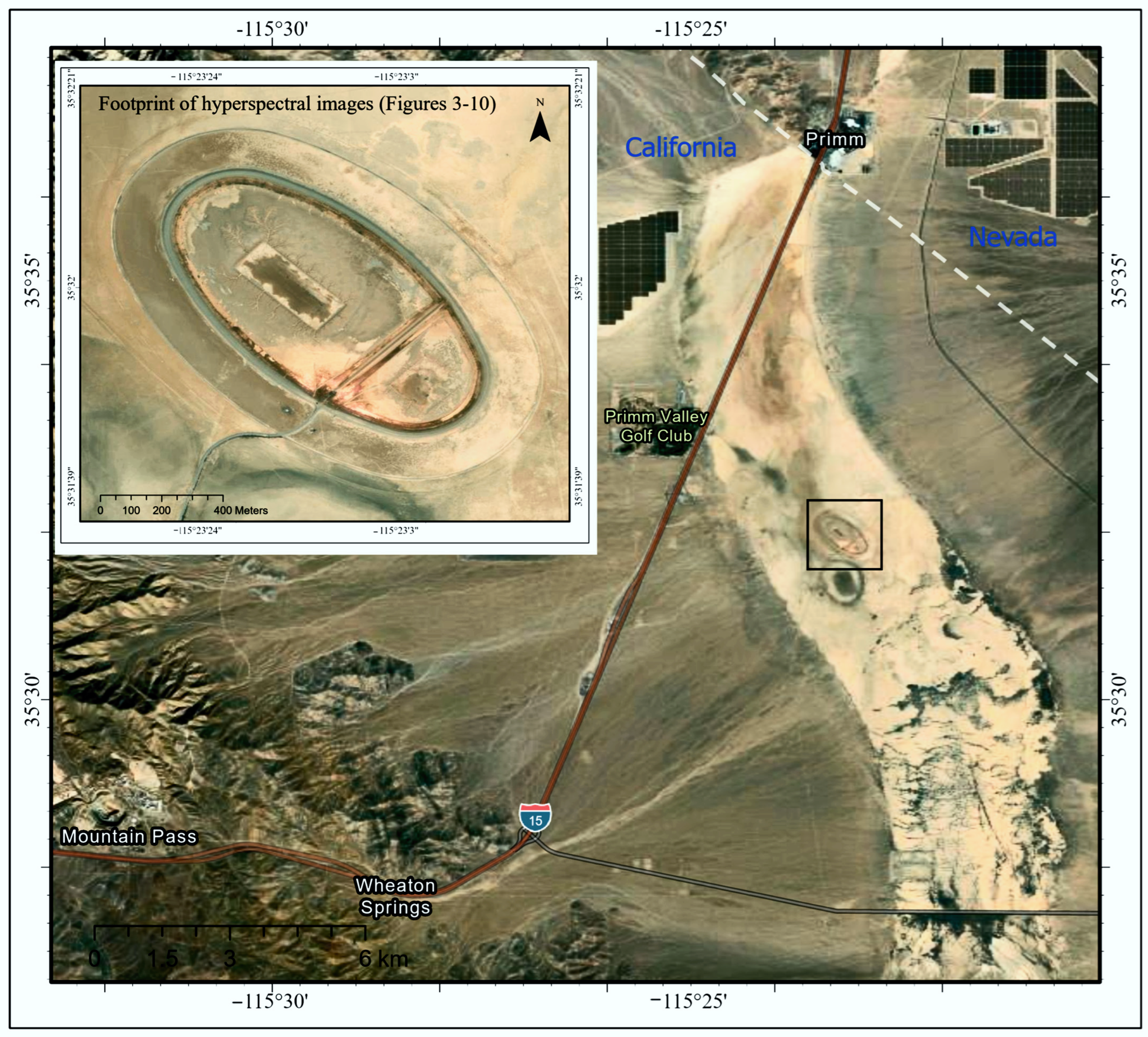
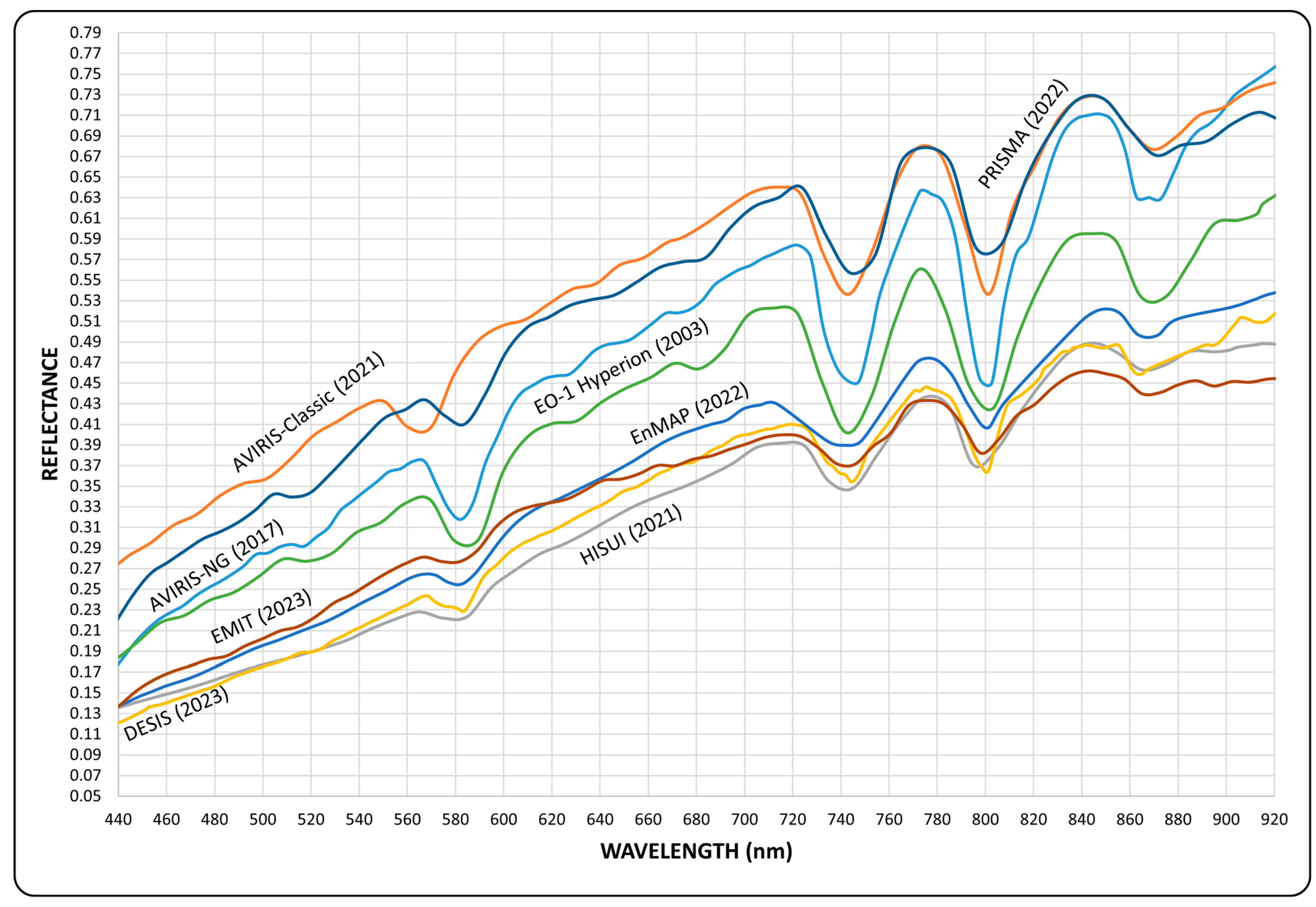



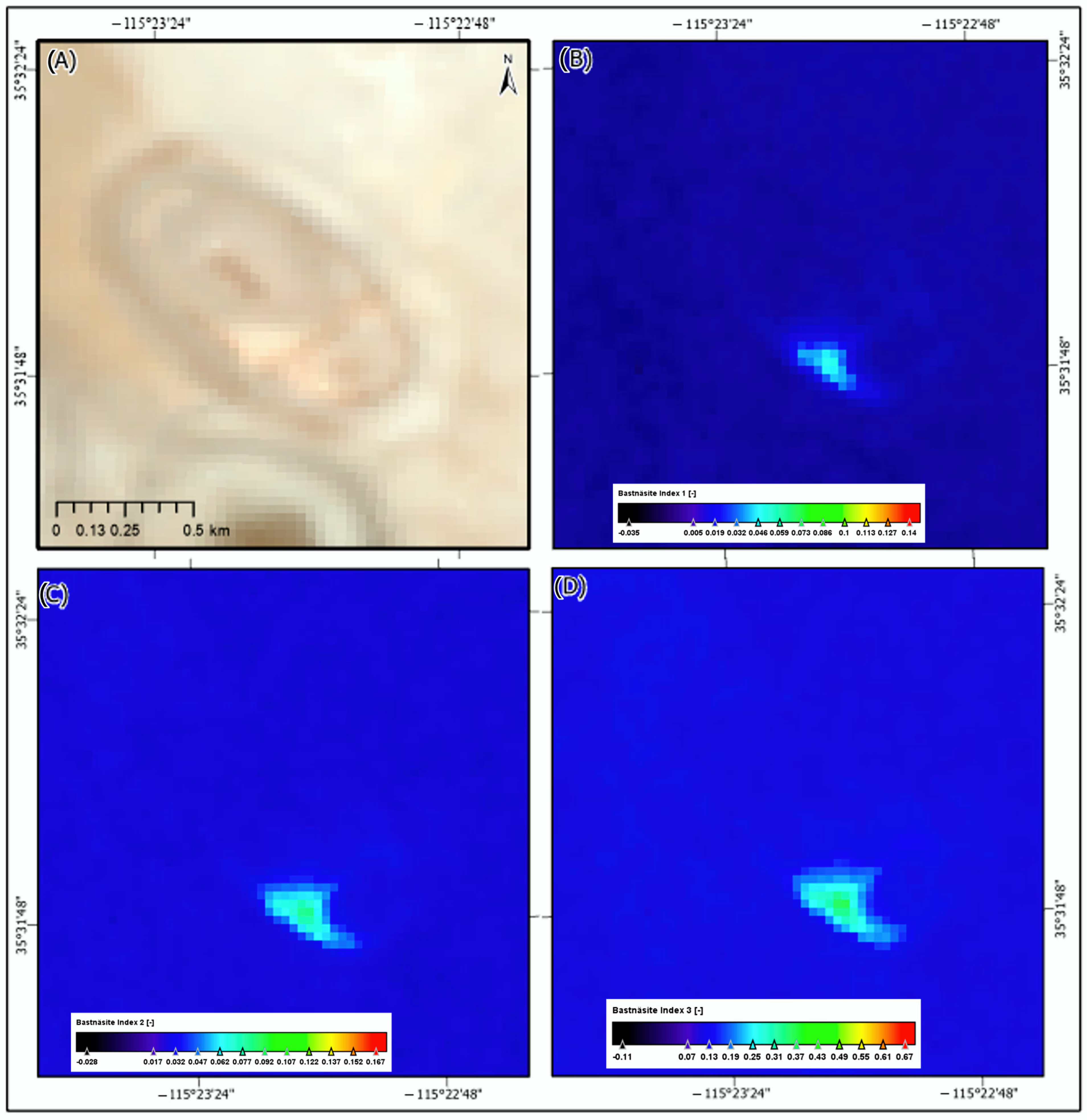
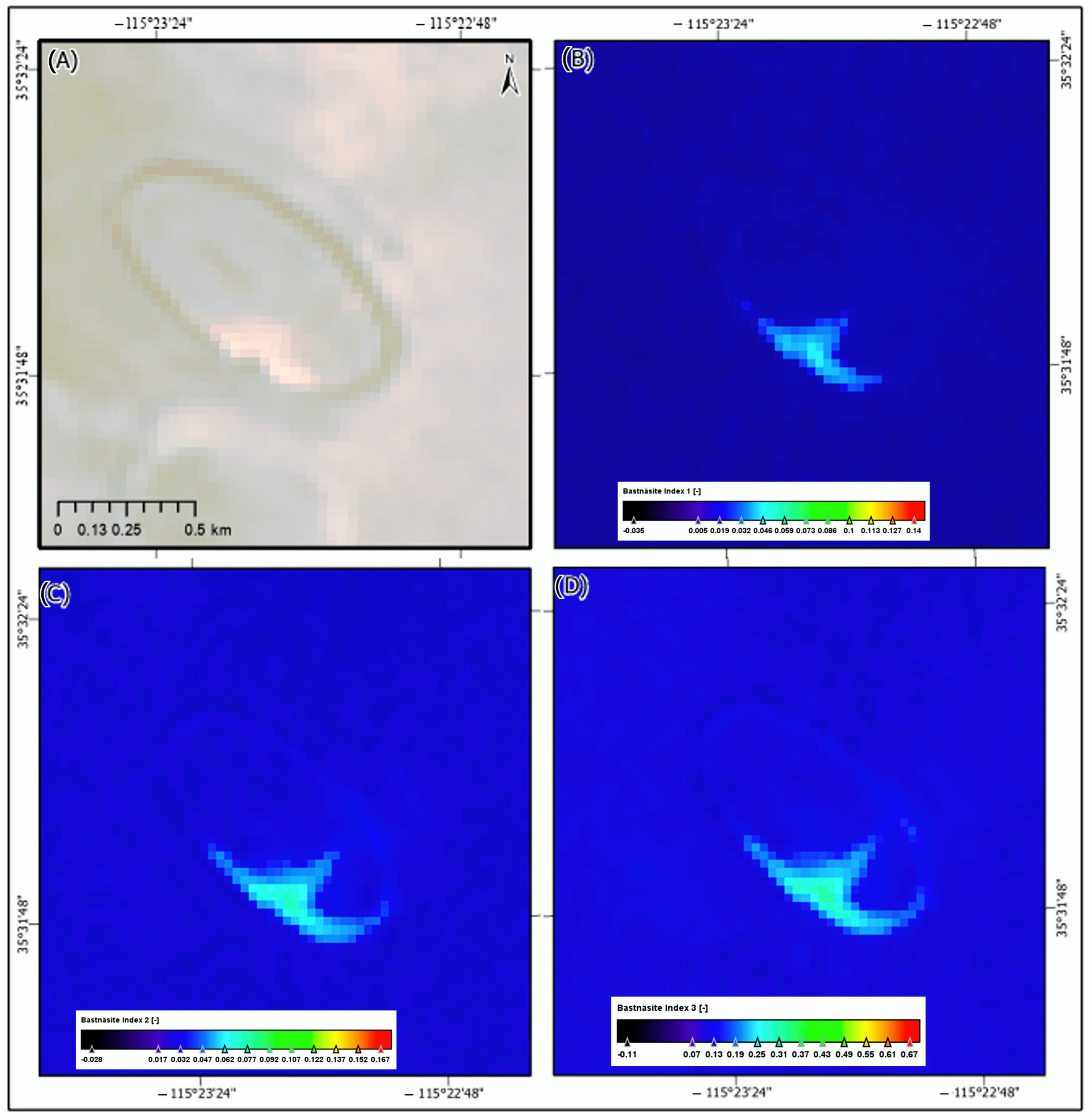

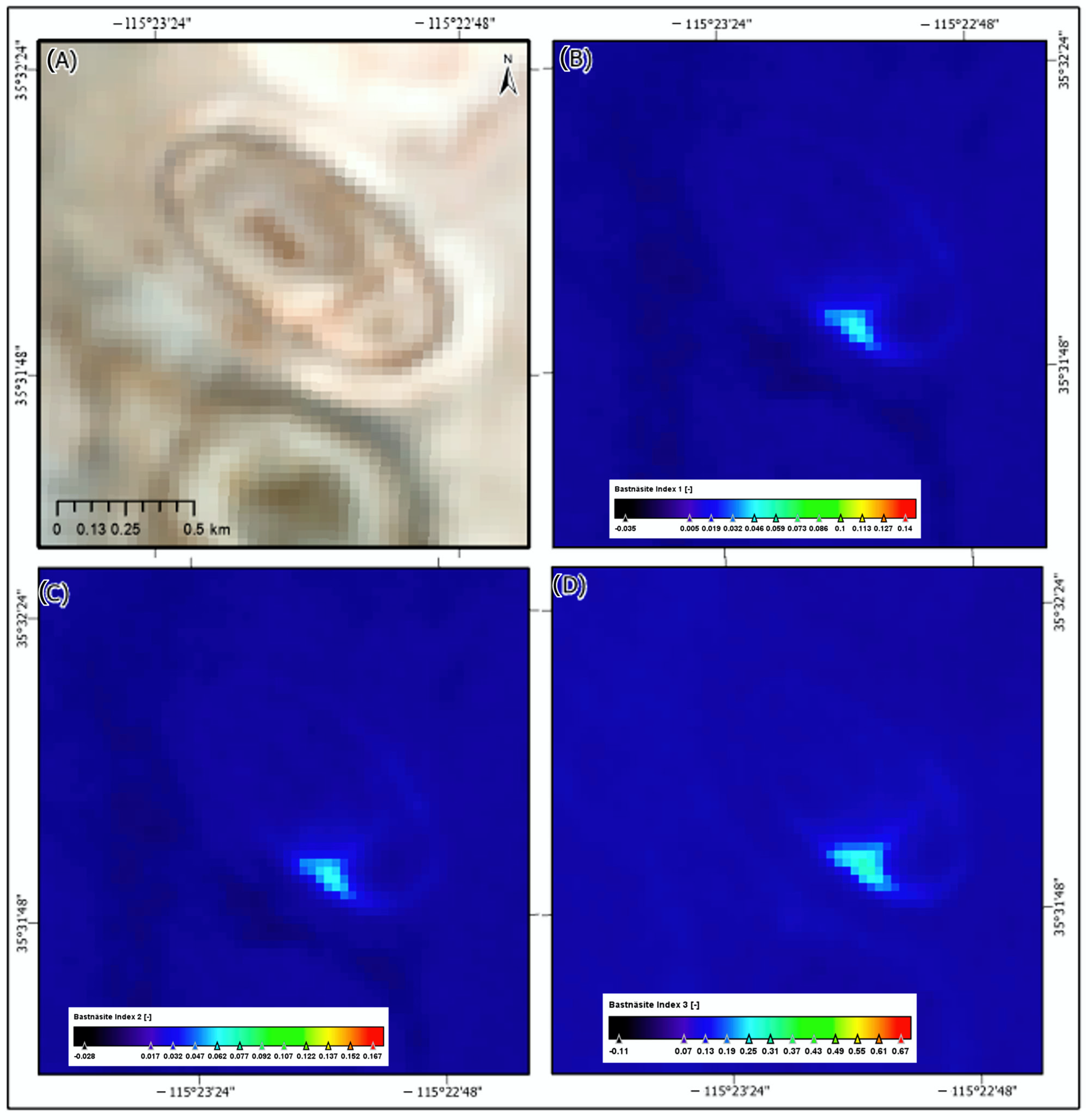

| Sensor Name | P1 | T1 | P2 | T2 | P3 | T3 | P4 | T4 | P5 |
|---|---|---|---|---|---|---|---|---|---|
| AVIRIS-NG | 567.0 | 577.1 | 712.3 | 742.3 | 772.4 | 797.4 | 837.5 | 867.6 | 922.7 |
| AVIRIS-Classic | 550.3 | 560.0 | 713.6 | 742.9 | 772.1 | 801.3 | 840.2 | 869.3 | 927.4 |
| HISUI | 565 | 575 | 715 | 735 | 775 | 795 | 835 | 865 | 915 |
| DESIS | 568.3 | 578.5 | 721.4 | 741.9 | 777.9 | 798.3 | 832.1 | 865.3 | 916.5 |
| EnMAP | 566.2 | 577.0 | 706.4 | 741.6 | 770.9 | 801.0 | 847.6 | 871.4 | 921.6 |
| EO-1 Hyperion | 559.1 | 579.5 | 711.7 | 742.3 | 772.8 | 803.3 | 844.0 | 864.4 | 932.6 |
| PRISMA | 567.2 | 583.8 | 713.7 | 744.1 | 775.3 | 796.1 | 849.2 | 870.7 | 924.0 |
| EMIT | 566.8 | 581.7 | 723.3 | 745.7 | 775.5 | 797.9 | 835.2 | 872.5 | 917.3 |
| Sensor Name | Spatial Resolution | Latitude of Pixel Center | Longitude of Pixel Center | Bastnäsite Index 1 | Bastnäsite Index 2 | Bastnäsite Index 3 |
|---|---|---|---|---|---|---|
| AVIRIS-NG | 4.1 m | 35°31′49.53″N | 115°23′10.01″W | 0.109 | 0.149 | 0.626 |
| AVIRIS-Classic | 15.7 m | 35°31′48.86″N | 115°23′9.31″W | 0.073 | 0.098 | 0.400 |
| HISUI | 20 m | 35°31′49.54″N | 115°23′9.47″W | 0.043 | 0.083 | 0.371 |
| DESIS | 30 m | 35°31′48.95″N | 115°23′7.51″W | 0.052 | 0.092 | 0.400 |
| EnMAP | 30 m | 35°31′49.68″N | 115°23′8.72″W | 0.043 | 0.079 | 0.345 |
| EO-1 Hyperion | 30 m | 35°31′48.97″N | 115°23′10.20″W | 0.181 | 0.196 | 0.806 |
| PRISMA | 30 m | 35°31′53.62″N | 115°23′4.73″W | 0.049 | 0.076 | 0.319 |
| EMIT | 60 m | 35°31′49.97″N | 115°23′7.64″W | 0.032 | 0.059 | 0.251 |
Disclaimer/Publisher’s Note: The statements, opinions and data contained in all publications are solely those of the individual author(s) and contributor(s) and not of MDPI and/or the editor(s). MDPI and/or the editor(s) disclaim responsibility for any injury to people or property resulting from any ideas, methods, instructions or products referred to in the content. |
© 2024 by the authors. Licensee MDPI, Basel, Switzerland. This article is an open access article distributed under the terms and conditions of the Creative Commons Attribution (CC BY) license (https://creativecommons.org/licenses/by/4.0/).
Share and Cite
Gadea, O.C.A.; Khan, S.D. Identification of a Potential Rare Earth Element Deposit at Ivanpah Dry Lake, California Through the Bastnäsite Indices. Remote Sens. 2024, 16, 4540. https://doi.org/10.3390/rs16234540
Gadea OCA, Khan SD. Identification of a Potential Rare Earth Element Deposit at Ivanpah Dry Lake, California Through the Bastnäsite Indices. Remote Sensing. 2024; 16(23):4540. https://doi.org/10.3390/rs16234540
Chicago/Turabian StyleGadea, Otto C. A., and Shuhab D. Khan. 2024. "Identification of a Potential Rare Earth Element Deposit at Ivanpah Dry Lake, California Through the Bastnäsite Indices" Remote Sensing 16, no. 23: 4540. https://doi.org/10.3390/rs16234540
APA StyleGadea, O. C. A., & Khan, S. D. (2024). Identification of a Potential Rare Earth Element Deposit at Ivanpah Dry Lake, California Through the Bastnäsite Indices. Remote Sensing, 16(23), 4540. https://doi.org/10.3390/rs16234540







